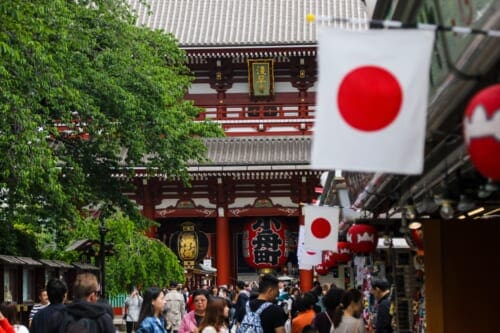If you ask the average Tokyoite about Tokyo Daibutsu 東京大仏 or Tokyo’s Giant Buddha, do not be surprised by the puzzled looks. You would think that being in the capital city and all, a sacred figure of these proportions would probably be a much more prominent spot than it actually is. Turns out, this overlooked 13-meter bronze giant is tucked away in the quiet residential streets of Itabashi-ku, quite far from the buzz of Shibuya and Shinjuku or the historical grounds of Asakusa and the surrounding shitamachi (traditional downtown) area. A true hidden gem known only among neighborhood locals.
Tokyoites can be forgiven though. Its famous cousin down south in Kamakura has several centuries of history as one of the most remarkable Buddhas in the area, while the one in Tokyo is a much more recent addition, having been built in 1977. So why the remote location though? It has to do with the historical significance of Jorenji, the Buddhist temple where the statue is located and a place with roots dating back to the early 1400s.
A Sanctuary of Refuge Through the Ages and Response to Destruction
Jorenji Temple (乗蓮寺) was founded in the early 15th century during the Muromachi period. The temple’s location in Itabashi traces back to its founding by the monk Ryoken Muteki (了賢無的), who sought to bring the teachings of the Jodo Shinsu school (浄土宗), also known as Pure Land Buddhism, to the people of this remote corner of Edo (Tokyo), which at the time was mostly a rural village. It quickly gained the favor of the population thanks to a personal land donation from the Shogun Ieyasu Tokugawa, and it remained a preferential temple for the Tokugawa clan, making it one of the most prestigious temples in the area.
Historically, the temple served as a place of refuge during crises, with its priests performing burial rites for those who perished during the Edo-period famines and later, for victims of natural disasters like the Great Kanto Earthquake in 1923.


After the firebombing raids of WWII destroyed much of Tokyo, Jorenji’s leaders reflected on these two disasters that plagued Tokyo in the 20th century and sought to build something that would offer hope and peace to the survivors. Also, after the war, the construction of a new expressway affected the original temple grounds, so in the 1970s it had to be relocated nearby to its current location. And so the new temple reopened with the illustrious addition.


Symbolism and history aside, Tokyo Daibutsu stands out more for its atmosphere than its scale. The statue’s setting in a quiet neighborhood is a chance to enjoy the stillness rarely found in central Tokyo. Cherry blossom season is an absolute highlight and this is definitely one of my favorite places in the city to enjoy sakura away from the usual crowds.
The Neighborhood Vibe
Part of the appeal of Tokyo Daibutsu is its location. Itabashi-ku is far from the typical tourist trail, allowing the opportunity to experience a more local side of Tokyo. After visiting Jorenji, a short walk around the neighborhood reveals a charming contrast between old and new Tokyo, with local parks and quiet streets. If you’re there, I especially recommend to also stop by:
Itabashi Historical Museum: A nice permanent exhibition about local history with many interesting artifacts and preserved houses and other buildings. There’s also a popular park with a pond in front of the museum.


Akatsuka Botanical Garden: A small and quiet garden with several hundreds of trees, plants and beautiful seasonal flowers. A special feature is its Manyo garden with a collection of medicinal herbs mentioned in the oldest anthology of Japanese poetry.

Akatsuka Park: During fall it’s one of the prettiest places in the area because of all the ginkgo trees that appear to create a vibrant yellow tunnel. The rest of the year is always a perfect place for a relaxed picnic or a leisurely walk.


Getting to Tokyo Daibutsu
Jorenji Temple is relatively easy to reach, despite its off-the-beaten-path vibe. The nearest station is Nishi-Takashimadaira on the Toei Mita Line, followed by a 20-minute walk. The temple and its grounds are free to enter, and visitors are welcome throughout the year. Bear in mind that Jorenji closes fairly early at 3:45pm so take this into account when planning your visit.
 Tokyo Daibutsu
Tokyo Daibutsu
TOURIST ATTRACTION- 5 Chome-28-3 Akatsuka, Itabashi City, Tokyo 175-0092, Japan
- ★★★★☆

Tokyo Daibutsu at Jorenji Temple may not have the fame of Kamakura’s Great Buddha, but it offers something that many larger tourist destinations don’t — solitude. And you’ll be able to say that you’ve been to a landmark that’s even hidden for many locals! If you’re looking to escape the crowds or discover something new, rest assured this is going to be a rewarding detour.













No Comments yet!